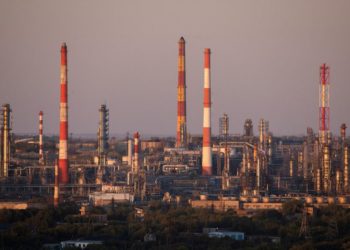A magnitude 8.8 earthquake struck off Russia’s Kamchatka Peninsula on July 29, triggering tsunami alerts for the entire U.S. West Coast and prompting evacuation warnings in Hawaii, the U.S. Geological Survey said.
The earthquake was recorded at 7:24 p.m. ET, about 78 miles east-southeast of Petropavlovsk-Kamchatsky, Russia, the U.S. Geological Survey (USGS) said in its updated assessment. The agency said the quake was shallow, at a depth of about 12 miles.
Multiple aftershocks were also recorded following the major quake, ranging between a magnitude of 5.2 and 6.9, according to the USGS.
A tsunami warning was in place for Hawaii and along Alaska’s remote Aleutian Islands. A tsunami could cause damage along coastlines of all islands in Hawaii, the weather service said, adding “urgent action should be taken to protect lives and property.”
A tsunami is a long series of waves that may extensively flood coastal area and present dangers that could continue for many hours after the initial waves arrive. All shores are at risk in Hawaii no matter which direction they face.
President Donald Trump took to social media to warn of the tsunami, saying that a watch was in effect for the Pacific Coast of the United States.
“Due to a massive earthquake that occurred in the Pacific Ocean, a Tsunami Warning is in effect for those living in Hawaii,” he posted on X. “A Tsunami Watch is in effect for Alaska and the Pacific Coast of the United States. … STAY STRONG AND STAY SAFE!”
Residents in the Aleutian Islands were advised to move out of the water and away from beaches, harbors, marines and inlets. Tsunamis can generate strong waves and currents, with waves that may last up to 45 minutes as it encroaches and recedes, the warning center stated. Coasts facing all directions are threatened because the waves can wrap around islands and headlands and into bays.
The warning center also issued a tsunami watch for the West Coast, including southern Alaska, British Columbia, Washington state, Oregon, and California, including Los Angeles Harbor. The watch extends inland along the Salish Sea in Washington to Port Angeles, Port Townsend, and Bellingham.
“This is a significant, real event,” said Reid Wolcott, a meteorologist with the weather service in Seattle. “The imminent threat is for Alaska and areas near the quake. The National Tsunami Warning Center needs additional observation information before more is known about the threat to the US West Coast.”
It will take time for ocean buoys and other observations to come in so that the tsunami warning centers can make a forecast with real data, Wolcott said.
Tsunami threat forces some coastal areas in Hawaii to evacuate
A tsunami warning was issued for Hawaii, according to the state’s Department of Emergency Management. The agency estimated that the first tsunami wave will arrive at 7:17 p.m., Hawaii Standard Time.
“A tsunami has been generated that could cause damage along coastlines of all islands in the state of Hawaii,” the agency said in a bulletin. “Urgent action should be taken to protect lives and property.”
The Honolulu Department of Emergency Management called for the evacuation of some coastal areas in Hawaii. “Take Action! Destructive tsunami waves expected,” the Honolulu Department of Emergency Management said on X.
Tsunami activity possible in Alaska
The tsunami warning for Alaska includes coastal areas from Attu to Samalga Pass. The tsunami advisory has been expanded to areas from Samalga Pass to Chignik Bay. Expected tsunami start times in Alaska include the following: 6:45 p.m., Unalaska; 7:25 p.m., Sand Point and 8:00 p.m. Cold Bay.
The National Tsunami Warning Center advises that tsunami activity is possible at Shemya, Alaska beginning at 4:46 p.m., Alaskan Daylight Time, then at 5:46 p.m. at Adak and 7:06 p.m. at Saint Paul, about 760 miles west of Anchorage.
A buoy south-southwest of Attu, Alaska detected a tsunami wave of 3 feet, the weather service reported. The measurements from DART buoys are from the deep ocean and are generally much smaller than the wave would be when it arrives at the coast, the weather service said.
Hazardous currents warned for coastal communities in California
In San Francisco and Monterey, California, the weather service expects to see tsunami heights of less than one feet, but advises it could present strong and hazardous currents.
“Move off the beach and out of harbors and marinas,” the weather service said. “Do not go to the coast to watch the tsunami.”
In San Diego, the weather service said the area should not expect widespread inundation, but advised people in coastal areas under the advisory to stay off the beach and out of harbors and marinas.
“Dangerous and powerful currents are still expected within the ocean and along the coast,” said Dial Hoang, a weather service meteorologist in San Francisco. “In 2011, a man near Crescent City died after he was swept out to sea while trying to photograph the tsunami coming in.”
Estimated tsunami start times for West Coast
Possible tsunami start times stretch from 8:20 p.m. local time in Kodiak, Alaska, southward along the coast to La Jolla, California, where tsunami activity would be expected to begin by 1:15 a.m. local time.
Estimated tsunami start times, in local times, for selected sites are:
-
Alaska: Kodiak – 8:20 p.m., Seward – 8:45 p.m., Sitka – 8:55 p.m., Homer – 9:40 p.m., and Craig – 9:55 p.m.
-
British Columbia: Langara – 10:05 p.m. and Tofino – 11:30 p.m.
-
Washington state: La Push – 11:35 p.m., Port Angeles – 12:20 a.m. on July 30, Port Townsend – 12:45 a.m. on July 30, and Bellingham – 1:10 a.m. on July 30
-
Oregon: Port Oxford – 11:40 p.m., Charleston – 11:45 p.m., Brookings – 11:50 p.m., Seaside – 11:55 p.m., and Newport – 11:55 p.m.
-
California: Fort Bragg – 11:50 p.m., Monterey – 12:15 a.m. on July 30, San Francisco – 12:40 a.m. on July 30, Los Angeles Harbor – 1:05 a.m. on July 30, and La Jolla – 1:15 a.m. on July 30
Tsunami alerts issued for Japan, Pacific Islands
The Japan Weather Agency upgraded its warning, saying it expected tsunami waves of up to 10 feet to reach large coastal areas starting around 10:00 a.m. local time. Broadcast NHK said evacuation orders had been issued by the government for some areas.
The U.S. Tsunami Warning System also issued a warning of “hazardous tsunami waves” within the next three hours along some coasts of Russia, Japan and Hawaii. A tsunami watch was also in effect for the U.S. island territory of Guam and other islands of Micronesia.
In Guam, the weather service is warning of sea level fluctuations and strong ocean currents that could be a hazard along beaches and in harbors. The weather service has advised people to get out of the ocean and move away from beaches and harbors, following the instructions of local government officials. The estimated time of the activity in Guam, Rota , Tinian and Saipan is 2:37 p.m. local time.
A tsunami advisory also is in effect for American Samoa, where hazardous sea level fluctuations and strong ocean currents could occur beginning at 9:39 p.m. local time.
Earthquake in Russia was ‘the strongest in decades of tremors’
The powerful earthquake generated a tsunami of up to 13 feet in Russia, prompting evacuations and damaging buildings, officials said.
“Today’s earthquake was serious and the strongest in decades of tremors,” Kamchatka Governor Vladimir Solodov said in a video posted on the Telegram messaging app, according to Reuters. He added that according to preliminary information there were no injuries, but a kindergarten was damaged.
Kamchatka and Russia’s Far East sit on the Pacific Ring of Fire, a geologically active region that is prone to major earthquakes and volcanic eruptions.
What do tsunami alerts mean?
The National Weather Service said tsunami messages are issued by the tsunami warning centers to alert local authorities and the public of a possible tsunami. There are four levels of tsunami alerts, according to the weather service:
-
Tsunami Warning: “Take Action—Danger! A tsunami that may cause widespread flooding is expected or occurring. Dangerous coastal flooding and powerful currents are possible and may continue for several hours or days after initial arrival.”
-
Tsunami Advisory: “Take Action—A tsunami with potential for strong currents or waves dangerous to those in or very near the water is expected or occurring. There may be flooding of beach and harbor areas.”
-
Tsunami Watch: “Be Prepared—A distant earthquake has occurred. A tsunami is possible.”
-
Tsunami Information Statement: “Relax—An earthquake has occurred, but there is no threat or it was very far away and the threat has not been determined. In most cases, there is no threat of a destructive tsunami.”
How does NOAA track tsunamis?
A real-time tsunami monitoring system created by the Pacific Marine Environmental Laboratory in Washington placed buoys at strategic locations throughout the ocean and they play a critical role in tsunami forecasting, according to the National Oceanic and Atmospheric Administration. The buoys are named DART, for Deep-ocean Assessment and Reporting of Tsunamis.
When a tsunami event occurs, the first information available is the seismic information from the preceding earthquake, according to NOAA. As the tsunami wave moves across the ocean, it reaches the DART systems, which report sea level information measurements to the Tsunami Warning Centers. That buoy data is used to refine estimates of the tsunami source and to make the forecasts for watches, warnings and evacuations.
The Pacific Marine Environmental Laboratory is working on a third generation of the buoy system, but the laboratory is one of those proposed to be closed under the budget NOAA has proposed for the coming year.
Contributing: Reuters
This article originally appeared on USA TODAY: 8.8 earthquake off Russia triggers tsunami alert for US West Coast
The post Tsunami alerts issued for Alaska, West Coast after magnitude 8.8 earthquake off Russia appeared first on USA TODAY.




